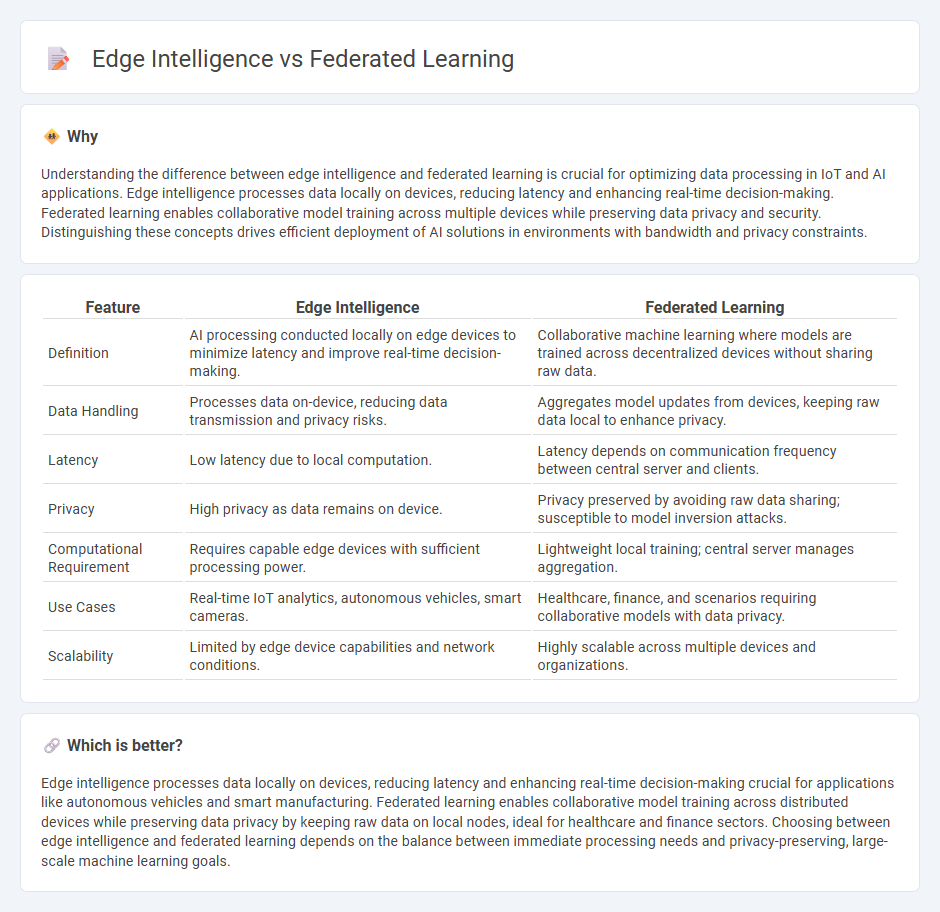
Edge intelligence processes data locally on devices, enhancing real-time decision making and reducing latency in applications like autonomous vehicles and smart cities. Federated learning enables collaborative model training across multiple devices without sharing raw data, preserving privacy while improving machine learning performance. Explore deeper insights into how edge intelligence and federated learning reshape modern AI ecosystems.
Why it is important
Understanding the difference between edge intelligence and federated learning is crucial for optimizing data processing in IoT and AI applications. Edge intelligence processes data locally on devices, reducing latency and enhancing real-time decision-making. Federated learning enables collaborative model training across multiple devices while preserving data privacy and security. Distinguishing these concepts drives efficient deployment of AI solutions in environments with bandwidth and privacy constraints.
Comparison Table
| Feature | Edge Intelligence | Federated Learning |
|---|---|---|
| Definition | AI processing conducted locally on edge devices to minimize latency and improve real-time decision-making. | Collaborative machine learning where models are trained across decentralized devices without sharing raw data. |
| Data Handling | Processes data on-device, reducing data transmission and privacy risks. | Aggregates model updates from devices, keeping raw data local to enhance privacy. |
| Latency | Low latency due to local computation. | Latency depends on communication frequency between central server and clients. |
| Privacy | High privacy as data remains on device. | Privacy preserved by avoiding raw data sharing; susceptible to model inversion attacks. |
| Computational Requirement | Requires capable edge devices with sufficient processing power. | Lightweight local training; central server manages aggregation. |
| Use Cases | Real-time IoT analytics, autonomous vehicles, smart cameras. | Healthcare, finance, and scenarios requiring collaborative models with data privacy. |
| Scalability | Limited by edge device capabilities and network conditions. | Highly scalable across multiple devices and organizations. |
Which is better?
Edge intelligence processes data locally on devices, reducing latency and enhancing real-time decision-making crucial for applications like autonomous vehicles and smart manufacturing. Federated learning enables collaborative model training across distributed devices while preserving data privacy by keeping raw data on local nodes, ideal for healthcare and finance sectors. Choosing between edge intelligence and federated learning depends on the balance between immediate processing needs and privacy-preserving, large-scale machine learning goals.
Connection
Edge intelligence leverages decentralized data processing at the network's edge to enable real-time analytics and decision-making. Federated learning enhances this by allowing multiple edge devices to collaboratively train machine learning models locally, preserving data privacy and reducing latency. Together, they optimize distributed AI deployments by combining localized computation with collective model improvement without centralized data aggregation.
Key Terms
Decentralized Training
Federated learning enables decentralized training by aggregating local model updates from multiple edge devices without transferring raw data, enhancing privacy and reducing network bandwidth usage. Edge intelligence distributes AI processing across edge nodes to improve latency and real-time decision-making while maintaining data sovereignty. Explore further how decentralized training in federated learning and edge intelligence transforms AI deployment at the network edge.
On-Device Processing
Federated learning enables decentralized model training directly on devices, enhancing data privacy by keeping user information local and reducing the need for centralized data aggregation. Edge intelligence involves deploying AI algorithms on edge devices, facilitating real-time decision-making and lowering latency through localized on-device processing. Explore further to understand how these technologies optimize performance and security in distributed AI systems.
Model Aggregation
Federated learning relies heavily on secure and efficient model aggregation techniques to combine updates from distributed devices without compromising data privacy, often using algorithms like FedAvg to reduce communication overhead. Edge intelligence integrates real-time analytics and local processing at the network edge, optimizing model aggregation by balancing computational load between edge nodes and centralized servers. Explore detailed comparisons of model aggregation strategies in federated learning and edge intelligence to enhance distributed AI system performance.
Source and External Links
What Is Federated Learning? | IBM - Federated learning is a decentralized machine learning approach where client nodes train a global model using their local data, with a central server aggregating updates to improve the model without collecting raw data, enhancing privacy and enabling collaborative learning across devices.
What is federated learning? - Federated learning allows multiple parties to collaboratively train AI models by iteratively training on their own data, encrypting updates, and integrating improvements into a central model, thus never exposing raw personal data during the process.
Federated learning - Federated learning is a machine learning technique where multiple clients collaboratively train a model while keeping their data decentralized, exchanging only model parameters rather than raw data, and is especially motivated by concerns around data privacy, access rights, and data minimization.
 dowidth.com
dowidth.com